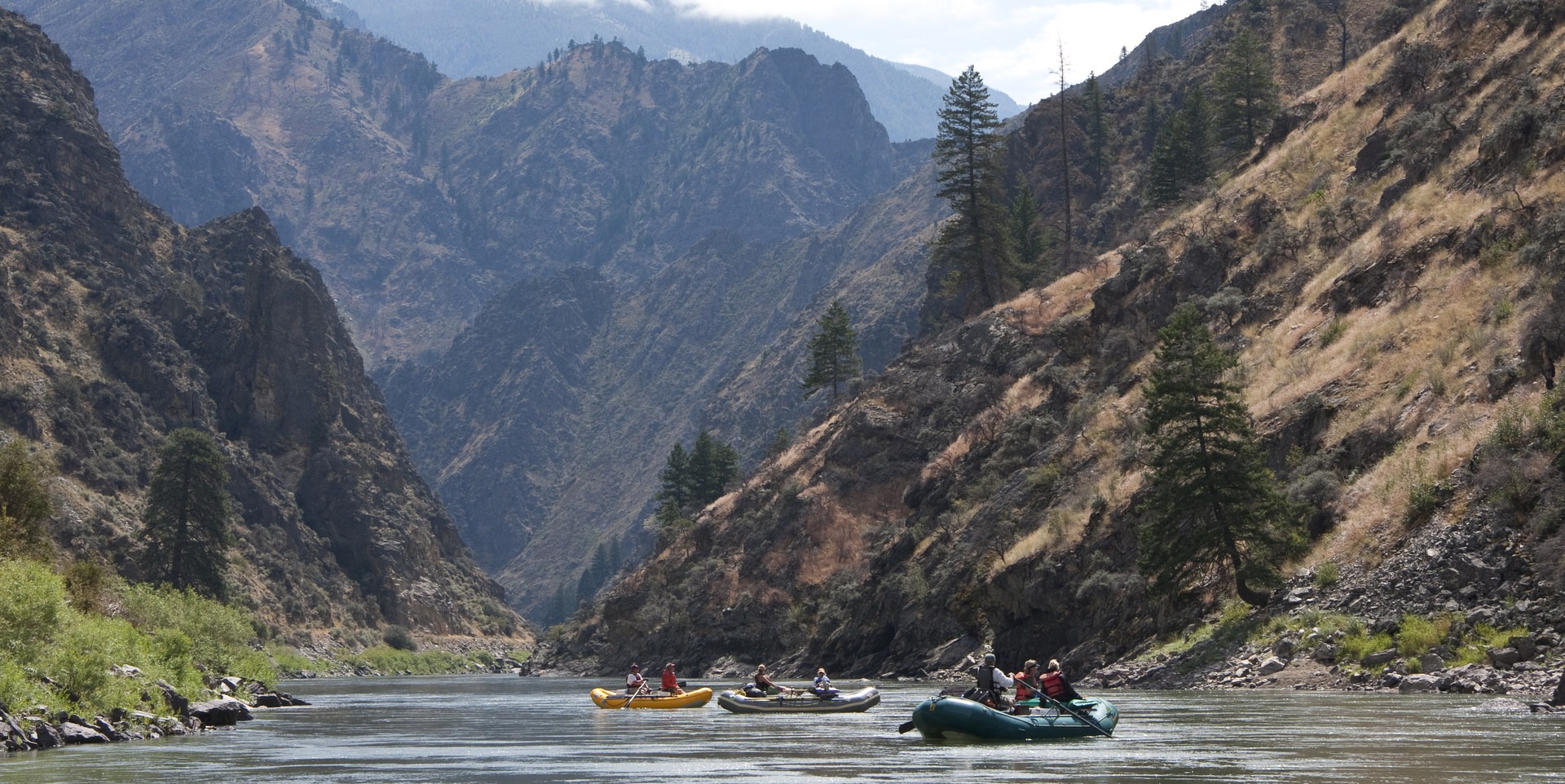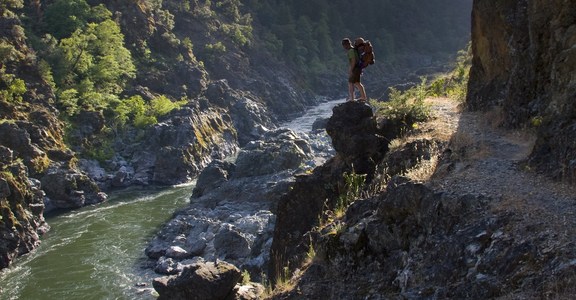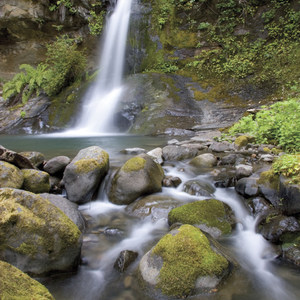You are here
These daily descriptions are intended to provide a description of a typical six-day Middle Fork rafting trip. Trip length, campsite selection, and group itineraries will vary.
For more general information about the Middle Fork check out this Adventure Overview of the river.
Day 6 - Canyon Description
The last 7 miles through Impassable Canyon slice a northerly course through the narrowest and deepest part of the canyon. The inner walls rise steeply for 2,000 feet before connecting to mellower ridgelines and mountain slopes above. Roaring Creek enters Hancock Rapid (mile 92.2) from river right after dropping 6,980 feet off the north face of Mount McGuire (10,082 feet), making it the deepest point in the canyon.
The ecology and vegetation does not change much here, and the canyon feels very similar to the latter half of day five. The metamorphic rocks continue all the way to the confluence with the Main Salmon, though they look and feel less broken and more slab-like in this final rush of river. As boaters turn the corner to onto Solitude Camp, a huge 1,000-foot wall of tilted slabs flanks the left side of the river. Downstream, giant eroded boulders choke the river channel forming significant rapids. At low water, the folds and curves of the raw stone are exposed in beautiful water-polished faces.
The river is crossed by a large dike that has eroded into a free-standing ridge of blocky slabs at the mouth of Goat Creek. In full view from the calm pool upstream, this feature identifies both Goat Creek Rapid (mile 94.9) as well as the final turn on the Middle Fork upstream of the confluence with the Main Salmon.
In the mile-long straightaway to the confluence, the intensity of metamorphism grades into metamorphic schist. A layperson will note this change by the more layered, plate-like nature of the rocks along the left bank. Schists that break apart into talus piles also tend to have smoother, more reflective faces on the individual boulders.
Frequently the water of the Middle Fork has greater clarity than the Main Salmon, and it is fun to float over the mixing and swirling boundary between the two rivers. Unlike the Middle Fork, the Main Salmon flows almost due west, which can result in annoying up-canyon winds for the last few miles to Cache Bar. Though sunnier and less confined, the final 2.5 miles on the Main Salmon flow though an equally rugged desert canyon. The only drawback is the dirt road overhead and the pending reality of re-entry after six blissful days in the Frank Church–River of No Return Wilderness.
Day 6 - Whitewater Description
From Otter Bar (mile 90.3) it is only a half-day float to the take-out at Cache Bar (mile 99.1). In that short stretch, however, rafters will come across some of the biggest and most frequent rapids on the trip.
Things get busy right off the bat with Foreplay and Son of Rubber, two rapids in the lead-up to Rubber, Class IV (mile 91.3). Though these are mostly washed out at high water, they get larger at lower flows. A big rock splits the main flow in Son of Rubber and often tips inflatable kayakers. Rescuers need to be ready for a VERY quick rescue to avoid an unpleasant swim into and through Rubber just downstream.
Rubber is probably the most notorious rapid on the river. It can be snuck along the left bank above 6 feet, but why would you want to do that? At higher flows (it is probably the biggest around 5 feet) it is a fairly straightforward crashing wave train IF you cock your nose into the monster left side later wave in order to hit it straight on. Otherwise, it has been know to quickly roll plenty of boats upside down. At lower flows, two large rocks begin to emerge at the bottom of the wave train, and these can cause some minor wrecks.
The next big rapid is Hancock, Class III (mile 92.2), a long S-turn sandwiched between the mouth of two tributaries. At extreme flows, the entrance to Hancock is reported to have giant standing waves that exceed 20 feet, but otherwise it is a fun wave train that leads into the middle of the rapid. The impressive “Broken Eggshell” rock marks the middle of Hancock (buried around 5 feet), which is a mess of small waves or a boulder garden depending on the flows. The crux of Hancock is the lower third, which narrows into an impressive wave train that pushes into a cliff wall at the bottom right. There are a few lurking holes in this lower section at various levels, so keep it straight!
About a 1.5 miles downstream from Hancock is Devil’s Tooth, Class IV (mile 93.8) followed in short succession by House of Rocks, Class III (93.9). Both are formed by a constriction of huge boulders in a very narrow section of the canyon. Both sport massive holes at higher water (though with plenty of space on either side along the left bank) and complicated and technical runs at low water. The low water Devil’s Tooth line is very challenging to nail perfectly as it requires pushing across a narrow channel from right to left in order to avoid dropping over the Devil’s Tooth rock itself. The move is complicated by the restricted space for moving your oars among the big boulders.
House of Rocks is a fun, slow moving, swirly run through giant metamorphic boulders at low flows. A landslide in 2008 altered the rapid and created a hazardous low water sieve among right bank boulders for both hardshell and inflatable kayaks.
Clamshell Rock (mile 94.1), a massive water-polished boulder, clogs the river just downstream from House of Rocks. Buried at flows above 7 feet, the downstream overhanging side of the boulder can accommodate an entire paddle boat at low water. Immediately below Clamshell, Jump Off, Class III (mile 94.2) is a fun right to center run down a big wave train. At low water, it pinches into a narrow run between partially submerged rocks and the right bank.
Upper and Lower Goat Creek (mile 94.9 and 95.3) rapids offer a fun splashy read-and-run ride that leads into the final mile-long straightaway to the confluence with the Main Salmon. Typically more than twice the flow of the Middle Fork, the rapids on the Main Salmon to Cache Bar have less technical and bigger rolling wave trains. A landslide altered Cramer Creek, Class III+ (mile 98.4), the final rapid of the trip in 2003. What used to be a fun, swimmable wave train evolved into a big Class IV run down the right side of the debris fan. The rapid has mellowed a bit over time, but several mid-channel rocks evolve from big waves at high water to a huge hole around 3 feet. It is fairly easy to clip the right side of the hole, but boaters lulled into complacency by the long pool above can easily flip a raft within the last mile of the trip!
Previous Day – Middle Fork of the Salmon River Day – 5
Reference: All content excerpted from The Middle Fork of the Salmon River – A Comprehensive Guide by Idaho River Publications.
Logistics + Planning
Current Weather: Powered by Dark Sky







Preferable season(s)
Parking Pass
Pros
Cons
Put-in location (lat, long coordinates)
Take-out location (lat, long coordinates)
Recommended maximum flow
Recommended minimum flow
Features
Overall difficulty
Route Characteristics: Character
Suitable for
Our mission is to inspire adventure with beautiful, comprehensive and waterproof map-based guidebooks. Owner, publisher, and photographer Matt Leidecker, grew up exploring and guiding on the rivers in central Idaho. His award winning Middle Fork of the Salmon River – A Comprehensive Guide is the standard by which other river guidebooks are measured. Printed on virtually indestructible YUPO paper, IRP guides are truly unique all-in-one resources for adventure. Each book is loaded with full-color maps, stunning photographs, and information on the history, geology, and wildflowers. Visit Idaho River Publications to explore our guidebooks to the Rogue River in Oregon and the mountains of Central Idaho.


















Comments
Sign In and share them.